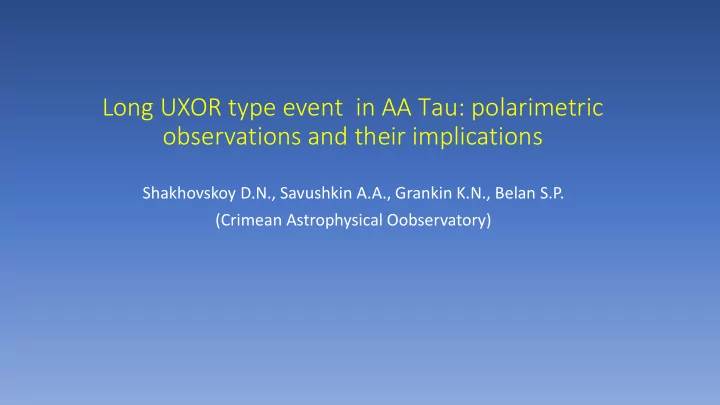

Long UXOR type event in AA Таu : polarimetric observations and their implications Shakhovskoy D.N., Savushkin A.A., Grankin K.N., Belan S.P. (Crimean Astrophysical Oobservatory)
Outline • AA Tau, a prototypical “dipper” type CTTS has been in long -lasting fainting event since 2011, similar to one being observed in RW Aur • We present broadband optical polarimetric observations of AA Tau in both “normal” pre - fading state and in “faint” state • Pattern of polarimetric variability changed radically with the onset o fading event • Our analysis suggest either radical change in scattering geometry or presence of aligned non- spherical grains in obscuring “screen” on Lthe LOS
AA Tau, a prototype “dipper” AA tau is CTTS with “eclipses” repeating with 8.2 days period, close to the rotational one (Bouvier+, 1999)
AA Tau, a prototype “dipper” Standard interpretation is a warp in the inner rim of disk, induced by interaction with magnetosphere (Bouvier+,1999)
AA Tau, a prototype “dipper” CS extinction mechanism of minima confirmed by polarimetry (Menard+, 2003)
AA Tau, a prototype “dipper” Alencar+,2010 found up to 40% CTTS in NGC2264 has signatures of AA Tau type variability, based on lightcurve classification. Introducing new “dipper” subclass.
Long and continuing fading event Since 2011 AA Tau faded by about 2 mag, With Av estimated as >4 mag (Bouvier+,2013)
ALMA imaging Loomis+,2017 found misalignment of outer disk (i=58 ) with inner disk i=75 estimated from star rotation data and optical coronography (Cox+, 2013). Major axis PA=93
Fading event explanations 1) Bouvier +, 2013 “density bump” in keplerian rotation at r > 8 a.u. 2) Loomis+,2017 “Streamers” connecting misaligned outer and inner disks.
Polarimetry data 1)”Bright state” 2000,2004,2008 19 nights BVRI at CrAO 1.25m telescope 2) ”Faint state” 2018,2019 9 nights VRI at CrAO 2.6m telescope
Bright state polarization Our 2000-2008 data basically confirm Menard+,2003 findings, confirm stable bright state variability pattern, fitted well by “disk scattering + contrast effect” model
Faint state polarization Polarization is 1 to 10%, doesn’t look like disk scattering at all. No apparent correlation with brightness
Faint state polarization Spectral dependence of polarization is remarkably stable
Interpretations This all is very problematic for any scattering-based interpretation. Scattering geometry might change fast and radically but IR data suggest that whatever happens, it happens far from the star. Or the “screen” should be extremely patchy, and obscure scattering matter unevenly. But little evidence for this from photometry. Contrast effect generally produces variable spectral dependence of polarization. But constant polarization spectrum is observed. A mechanism involving aligned dust grains on the LOS doesn’t have these problems, but it doesn’t provide much constraints for more quantitative explanations of the phenomenon.
Conclusion Probably the only non-speculative conclusion we can make is that The pattern of polarimetric variability changed completely with the onset of long fading event, and doesn’t fit simple “scattering + contrast effect” model. This provides extra weight to Bouvier+, 2013 interpretation of long fading event as not related to the activity on the disk’s inner rim, localizing instead the obscuring “screen” much farther from the star.
Recommend
More recommend